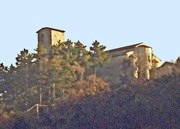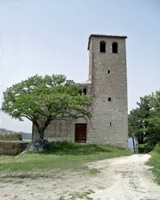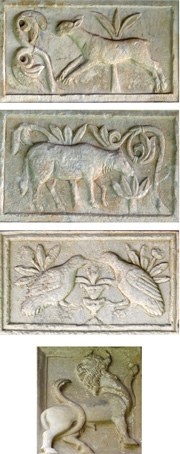


This church is traditionally associated with St Isaac, who founded a hermitage on Monteluco early in the 6th century. A noble lady called Gregoria, whom St Isaac helped to become a nun, provided some of the information for the account of his life in the Dialogues of Pope Gregory I. According to tradition, she provided the land on which he built San Giuliano for the communal services of the hermits. He was subsequently buried in the church.
The earliest surviving references to the monastery are in two letters of Pope Pelagius I (556-60) written shortly after St Isaac's death:
-
✴he wrote to Bishop Paolino, authorising him to ordain one of the monks of San Giuliano as a priest; and
-
✴he mentioned this ordination in a letter to the bishop of Camerino.
The complex subsequently passed to the Benedictines, who built the present church in the 12th century. The monastery enjoyed a long period of prestige. A diploma (1185) from Pope Urban III confirmed its possessions, which included the monastery of St Isaac "in civitate Spoletana" (now Sant' Ansano).
The monks gave the little church of Santa Caterina at the top of Monteluco to St Francis in 1218, and this later became part of the Convento di San Francesco di Monteluco.
In 1239, Pope Gregory IX placed the monastery under the jurisdiction of the Cistercian Abbazia di Chiaravalle in order to effect its reform. It first appears in the archives of Chiaravalle in 1256. Later entries point to a series of disputes. The abbots of San Giuliano and Chiaravalle finally accepted the arbitration of Cardinal John of Toledo in 1266, and he ruled in favour of the latter.
The community had fallen into decadence by the late 15th century. It was suppressed in 1502 and the monastery and its possessions were given to the Lateran Canons. However, they preferred to live at Sant' Ansano, and San Giuliano was abandoned. (The Eremo di Santa Maria delle Grazie replaced it as the focus for the religious lives of the remaining hermits on Monteluco).
It passed into private hands in the 19th century but the intervention of Giuseppe Sordini in the early 20th century led to its acquisition by the Commune.
(The adjacent pizzeria used to hold the key, but on my last visit in June 2008 the church was closed for restoration).
Exterior

The facade of the church has lost its upper part.

Interior
The interior of the church is in the form of a nave and two aisles, which culminate in an apse and two apsidal chapels.
An inscription (12th century) on the third column on the right records that Nicolò Bacarelli initiated a programme of restoration when he donated five columns to the church. This probably refers to the reconstruction of the colonnade between the nave and the right aisle: the other colonnade was probably reconstructed later in the 12th century.
Frescoes in the apse (1442)
The inscription records that Abbot Argento Campello commissioned these frescoes in the apse in 1442, These frescoes in two orders, which are attributed to Maestro di Eggi, depict:
-
✴the Coronation of the Virgin (above); and
-
✴St Benedict enthroned with:
-
•Blessed Gregoria (who holds the document in which she transferred her property here to St Isaac), St Isaac and St Maurus on the left; and
-
•St Placidus, St Julian and (probably) St Scholstica on the right.
This page in the website of the Fondazione Federico Zeri includes a black and white illustration.
Scenes from the life of St Isaac (15th century)
These damaged frescoes, which depict four scenes from the life of St Isaac, are on the presbytery walls.
Crypt
The crypt probably formed part of the ancient church. St Isaac was initially buried here, and his relics were subsequently translated into a fine sarcophagus (12th century). The relics and their sarcophagus were translated to what is now the Critpa di Sant' Isacco in 1502. After a series of moves in the 19th century, during which the relics and the sarcophagus were separated:
-
✴the relics are once more in the Cripta di Sant' Isacco, in a copy of the sarcophagus: and
-
✴the original sarcophagus is now in Room 5 of the Museo Nazionale del Ducato di Spoleto.

